length FORD F150 1999 10.G Owners Manual
[x] Cancel search | Manufacturer: FORD, Model Year: 1999, Model line: F150, Model: FORD F150 1999 10.GPages: 232, PDF Size: 1.56 MB
Page 67 of 232
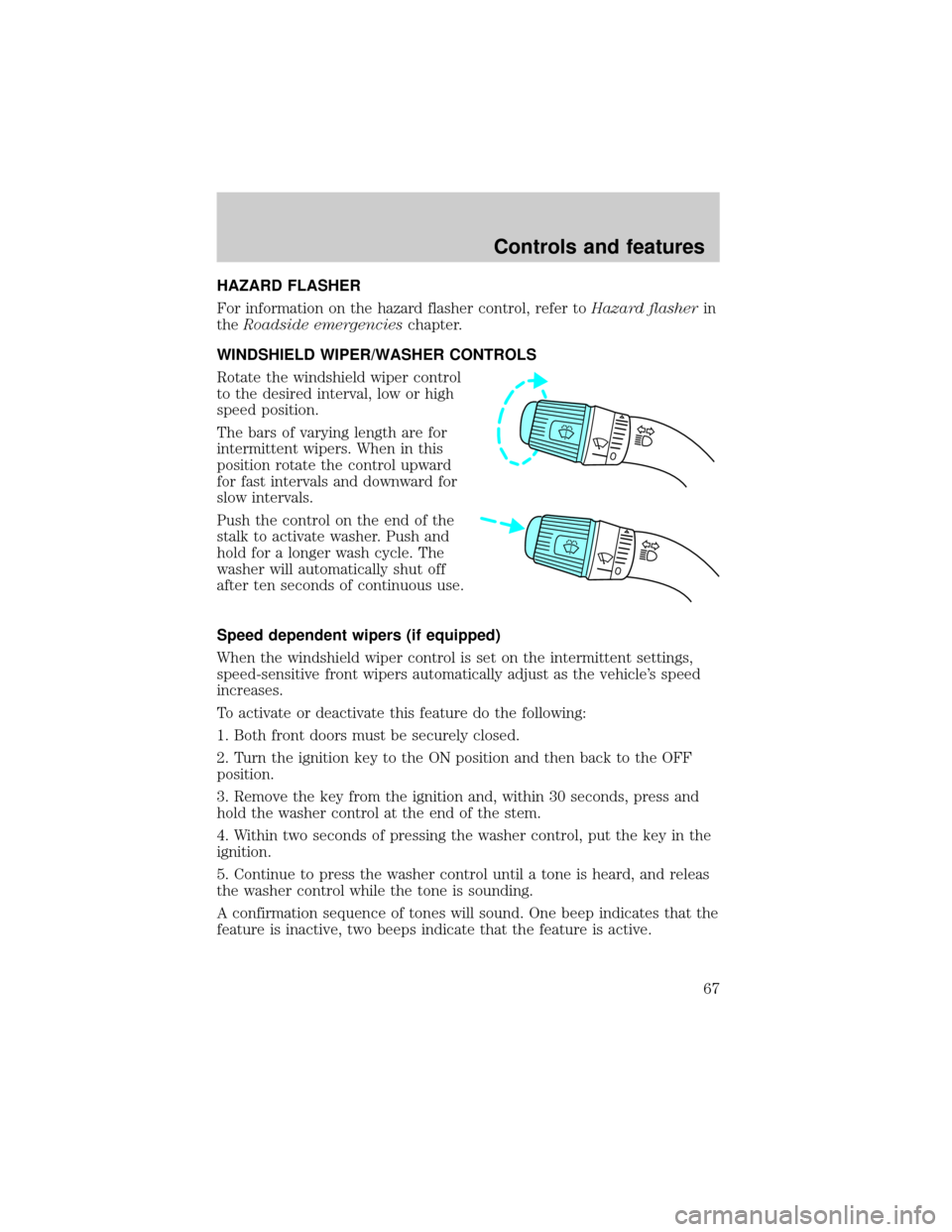
HAZARD FLASHER
For information on the hazard flasher control, refer toHazard flasherin
theRoadside emergencieschapter.
WINDSHIELD WIPER/WASHER CONTROLS
Rotate the windshield wiper control
to the desired interval, low or high
speed position.
The bars of varying length are for
intermittent wipers. When in this
position rotate the control upward
for fast intervals and downward for
slow intervals.
Push the control on the end of the
stalk to activate washer. Push and
hold for a longer wash cycle. The
washer will automatically shut off
after ten seconds of continuous use.
Speed dependent wipers (if equipped)
When the windshield wiper control is set on the intermittent settings,
speed-sensitive front wipers automatically adjust as the vehicle's speed
increases.
To activate or deactivate this feature do the following:
1. Both front doors must be securely closed.
2. Turn the ignition key to the ON position and then back to the OFF
position.
3. Remove the key from the ignition and, within 30 seconds, press and
hold the washer control at the end of the stem.
4. Within two seconds of pressing the washer control, put the key in the
ignition.
5. Continue to press the washer control until a tone is heard, and releas
the washer control while the tone is sounding.
A confirmation sequence of tones will sound. One beep indicates that the
feature is inactive, two beeps indicate that the feature is active.
Controls and features
67
Page 90 of 232
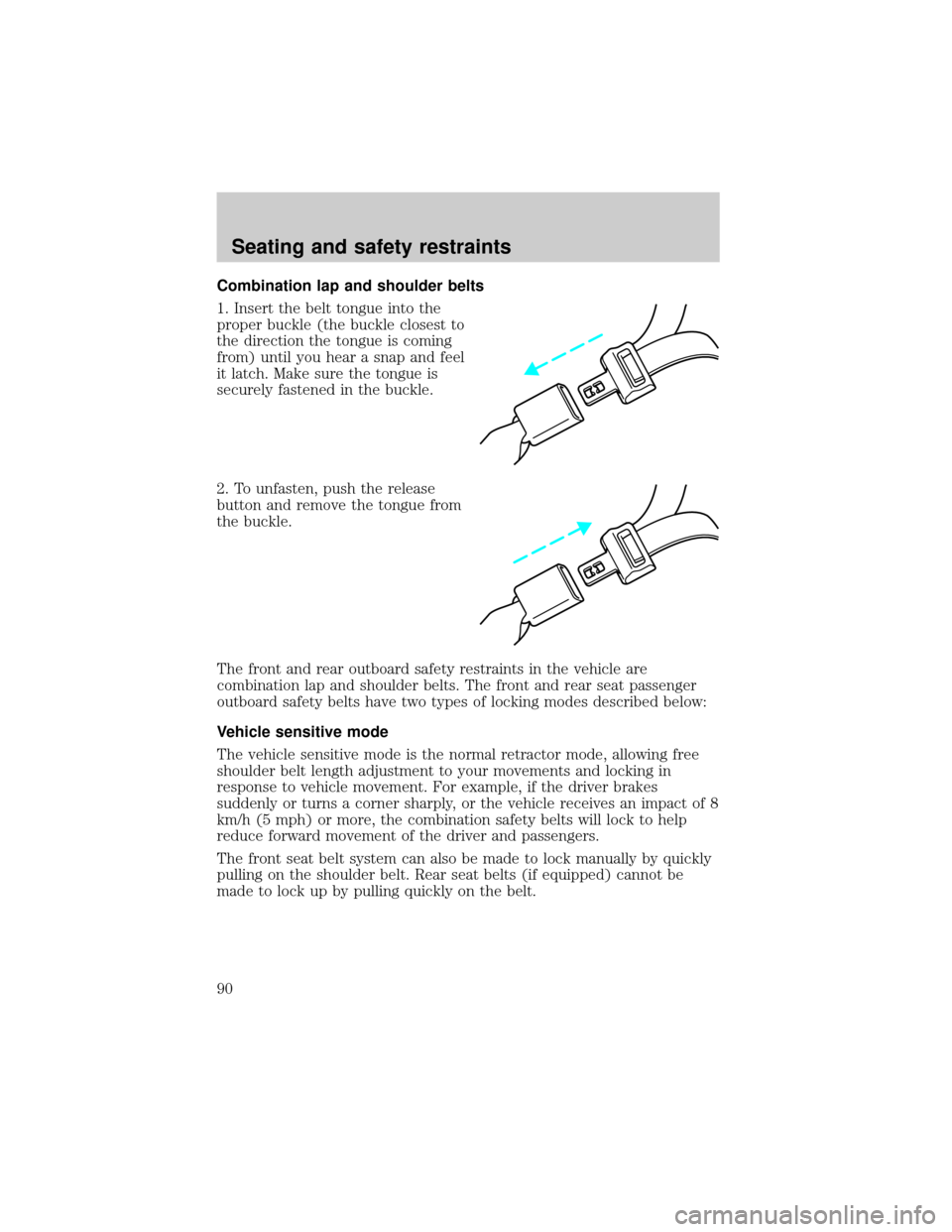
Combination lap and shoulder belts
1. Insert the belt tongue into the
proper buckle (the buckle closest to
the direction the tongue is coming
from) until you hear a snap and feel
it latch. Make sure the tongue is
securely fastened in the buckle.
2. To unfasten, push the release
button and remove the tongue from
the buckle.
The front and rear outboard safety restraints in the vehicle are
combination lap and shoulder belts. The front and rear seat passenger
outboard safety belts have two types of locking modes described below:
Vehicle sensitive mode
The vehicle sensitive mode is the normal retractor mode, allowing free
shoulder belt length adjustment to your movements and locking in
response to vehicle movement. For example, if the driver brakes
suddenly or turns a corner sharply, or the vehicle receives an impact of 8
km/h (5 mph) or more, the combination safety belts will lock to help
reduce forward movement of the driver and passengers.
The front seat belt system can also be made to lock manually by quickly
pulling on the shoulder belt. Rear seat belts (if equipped) cannot be
made to lock up by pulling quickly on the belt.
Seating and safety restraints
90
Page 93 of 232
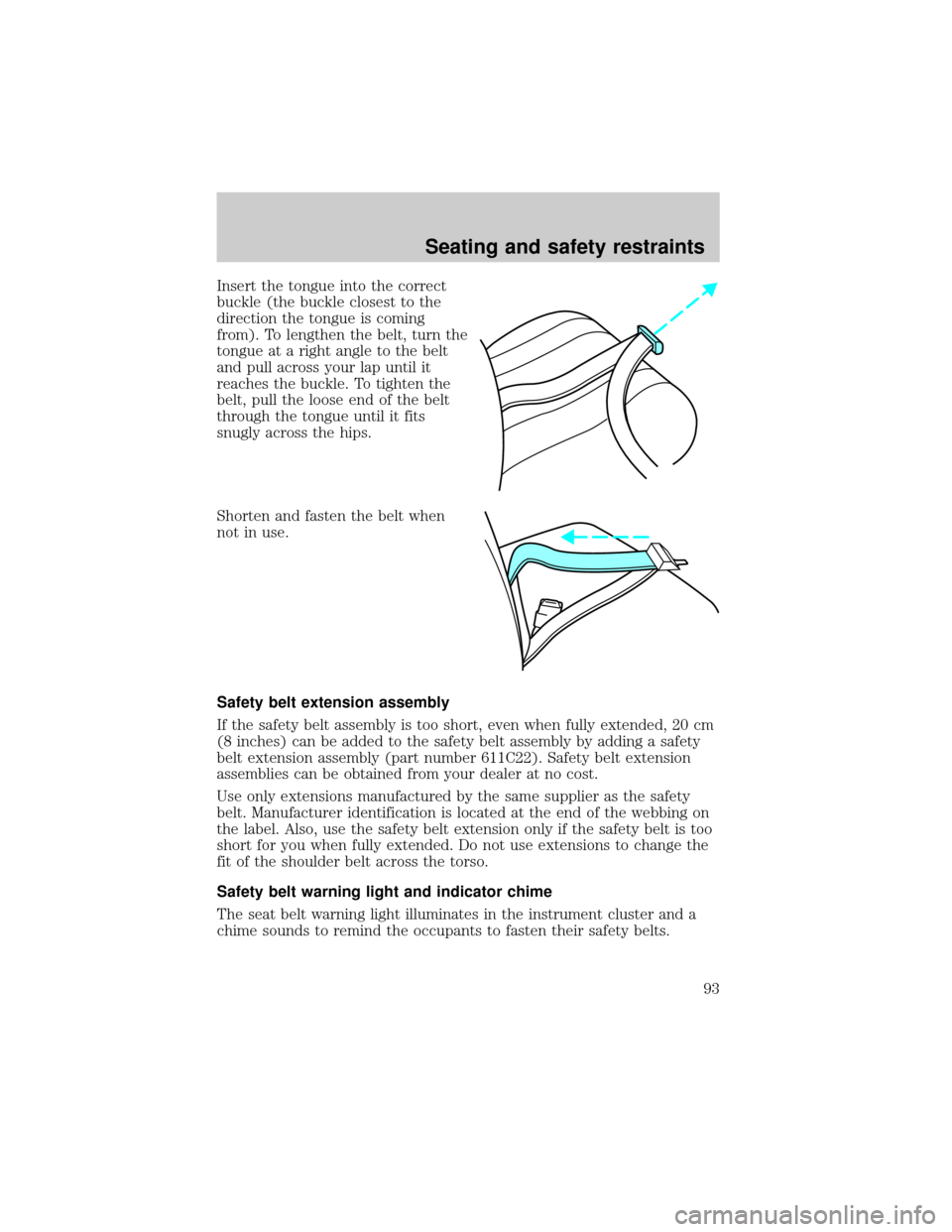
Insert the tongue into the correct
buckle (the buckle closest to the
direction the tongue is coming
from). To lengthen the belt, turn the
tongue at a right angle to the belt
and pull across your lap until it
reaches the buckle. To tighten the
belt, pull the loose end of the belt
through the tongue until it fits
snugly across the hips.
Shorten and fasten the belt when
not in use.
Safety belt extension assembly
If the safety belt assembly is too short, even when fully extended, 20 cm
(8 inches) can be added to the safety belt assembly by adding a safety
belt extension assembly (part number 611C22). Safety belt extension
assemblies can be obtained from your dealer at no cost.
Use only extensions manufactured by the same supplier as the safety
belt. Manufacturer identification is located at the end of the webbing on
the label. Also, use the safety belt extension only if the safety belt is too
short for you when fully extended. Do not use extensions to change the
fit of the shoulder belt across the torso.
Safety belt warning light and indicator chime
The seat belt warning light illuminates in the instrument cluster and a
chime sounds to remind the occupants to fasten their safety belts.
Seating and safety restraints
93
Page 108 of 232
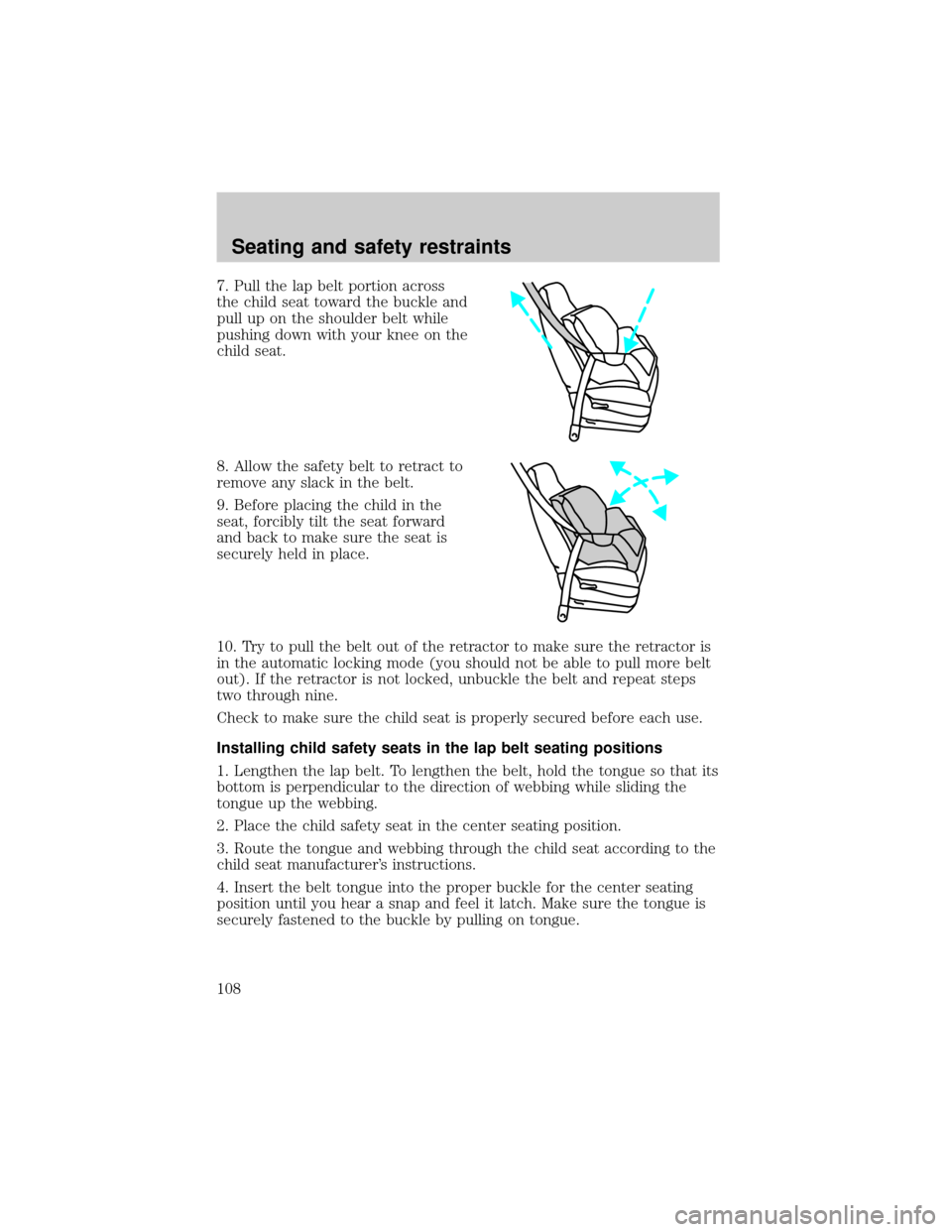
7. Pull the lap belt portion across
the child seat toward the buckle and
pull up on the shoulder belt while
pushing down with your knee on the
child seat.
8. Allow the safety belt to retract to
remove any slack in the belt.
9. Before placing the child in the
seat, forcibly tilt the seat forward
and back to make sure the seat is
securely held in place.
10. Try to pull the belt out of the retractor to make sure the retractor is
in the automatic locking mode (you should not be able to pull more belt
out). If the retractor is not locked, unbuckle the belt and repeat steps
two through nine.
Check to make sure the child seat is properly secured before each use.
Installing child safety seats in the lap belt seating positions
1. Lengthen the lap belt. To lengthen the belt, hold the tongue so that its
bottom is perpendicular to the direction of webbing while sliding the
tongue up the webbing.
2. Place the child safety seat in the center seating position.
3. Route the tongue and webbing through the child seat according to the
child seat manufacturer's instructions.
4. Insert the belt tongue into the proper buckle for the center seating
position until you hear a snap and feel it latch. Make sure the tongue is
securely fastened to the buckle by pulling on tongue.
Seating and safety restraints
108
Page 220 of 232
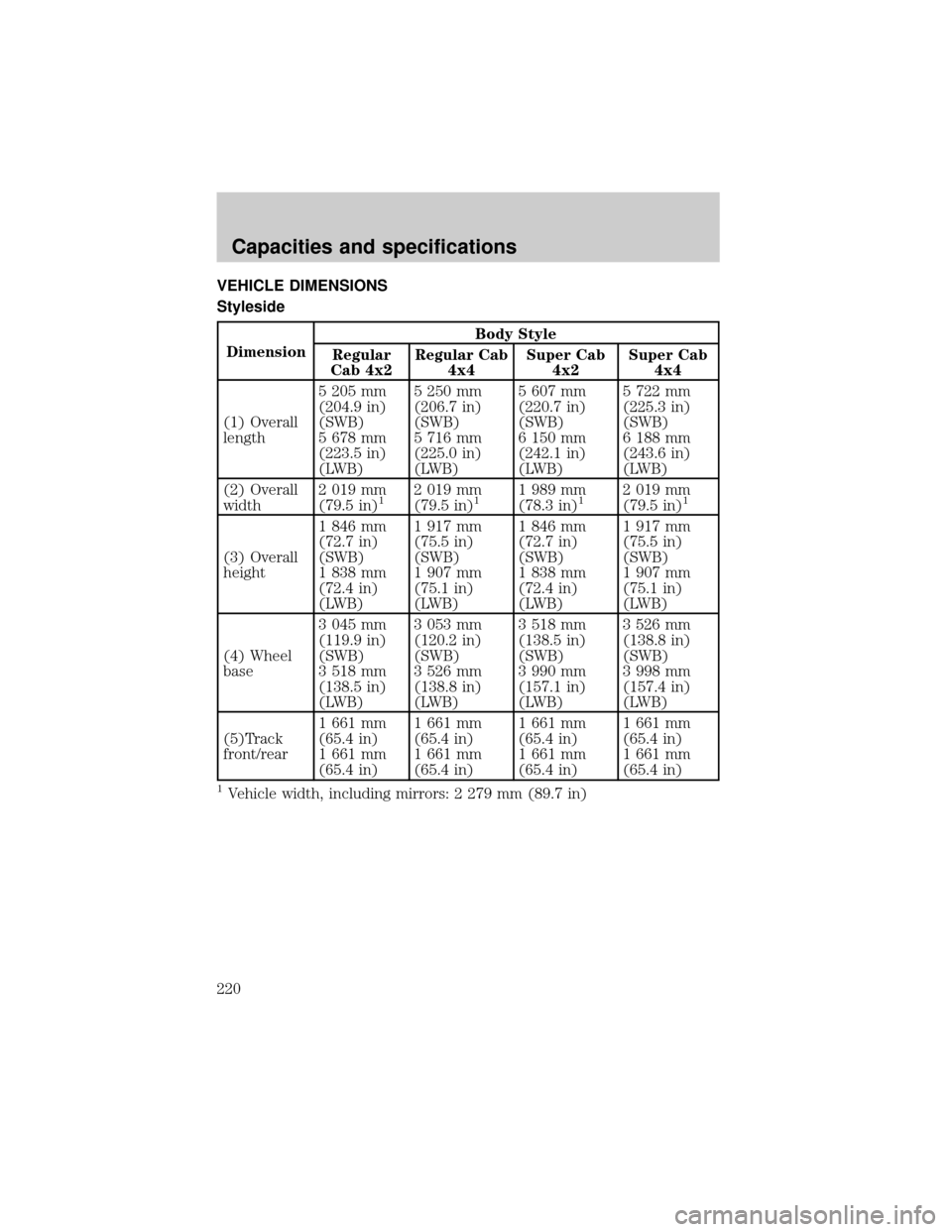
VEHICLE DIMENSIONS
Styleside
DimensionBody Style
Regular
Cab 4x2Regular Cab
4x4Super Cab
4x2Super Cab
4x4
(1) Overall
length5 205 mm
(204.9 in)
(SWB)
5 678 mm
(223.5 in)
(LWB)5 250 mm
(206.7 in)
(SWB)
5 716 mm
(225.0 in)
(LWB)5 607 mm
(220.7 in)
(SWB)
6 150 mm
(242.1 in)
(LWB)5 722 mm
(225.3 in)
(SWB)
6 188 mm
(243.6 in)
(LWB)
(2) Overall
width2 019 mm
(79.5 in)
12 019 mm
(79.5 in)11 989 mm
(78.3 in)12 019 mm
(79.5 in)1
(3) Overall
height1 846 mm
(72.7 in)
(SWB)
1 838 mm
(72.4 in)
(LWB)1 917 mm
(75.5 in)
(SWB)
1 907 mm
(75.1 in)
(LWB)1 846 mm
(72.7 in)
(SWB)
1 838 mm
(72.4 in)
(LWB)1 917 mm
(75.5 in)
(SWB)
1 907 mm
(75.1 in)
(LWB)
(4) Wheel
base3 045 mm
(119.9 in)
(SWB)
3 518 mm
(138.5 in)
(LWB)3 053 mm
(120.2 in)
(SWB)
3 526 mm
(138.8 in)
(LWB)3 518 mm
(138.5 in)
(SWB)
3 990 mm
(157.1 in)
(LWB)3 526 mm
(138.8 in)
(SWB)
3 998 mm
(157.4 in)
(LWB)
(5)Track
front/rear1 661 mm
(65.4 in)
1 661 mm
(65.4 in)1 661 mm
(65.4 in)
1 661 mm
(65.4 in)1 661 mm
(65.4 in)
1 661 mm
(65.4 in)1 661 mm
(65.4 in)
1 661 mm
(65.4 in)
1Vehicle width, including mirrors: 2 279 mm (89.7 in)
Capacities and specifications
220
Page 221 of 232
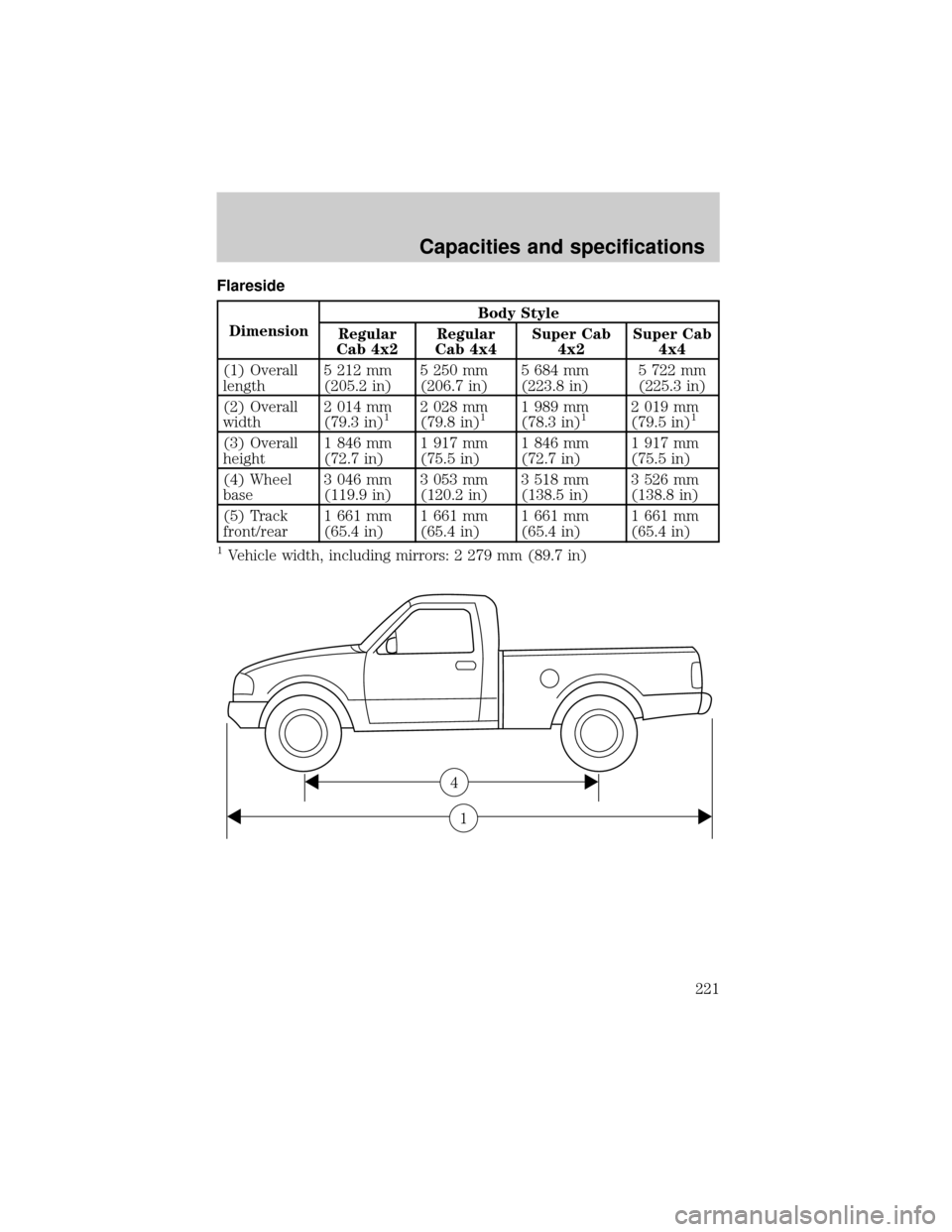
Flareside
DimensionBody Style
Regular
Cab 4x2Regular
Cab 4x4Super Cab
4x2Super Cab
4x4
(1) Overall
length5 212 mm
(205.2 in)5 250 mm
(206.7 in)5 684 mm
(223.8 in)5 722 mm
(225.3 in)
(2) Overall
width2 014 mm
(79.3 in)
12 028 mm
(79.8 in)11 989 mm
(78.3 in)12 019 mm
(79.5 in)1
(3) Overall
height1 846 mm
(72.7 in)1 917 mm
(75.5 in)1 846 mm
(72.7 in)1 917 mm
(75.5 in)
(4) Wheel
base3 046 mm
(119.9 in)3 053 mm
(120.2 in)3 518 mm
(138.5 in)3 526 mm
(138.8 in)
(5) Track
front/rear1 661 mm
(65.4 in)1 661 mm
(65.4 in)1 661 mm
(65.4 in)1 661 mm
(65.4 in)
1Vehicle width, including mirrors: 2 279 mm (89.7 in)
1
4
Capacities and specifications
221